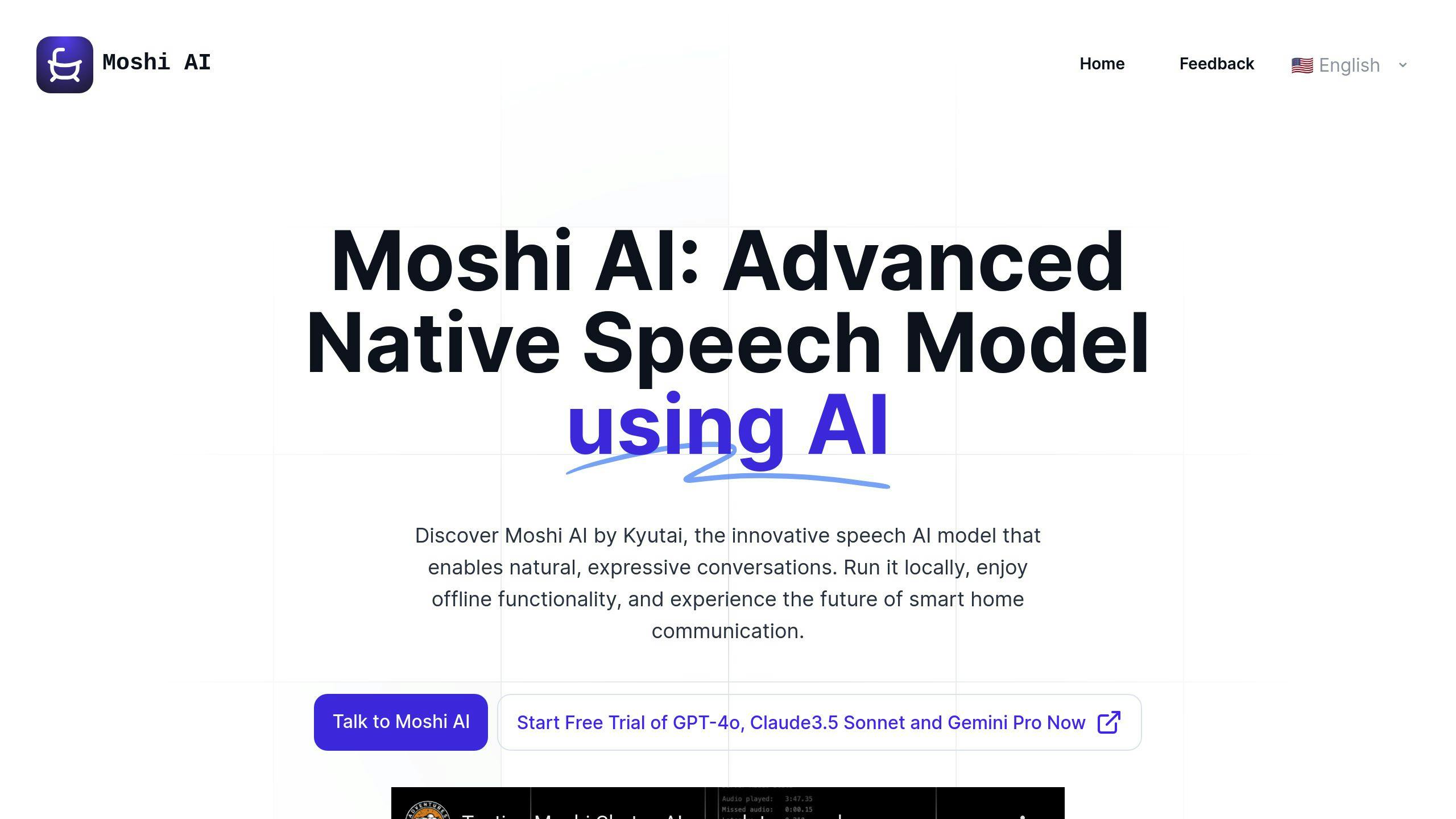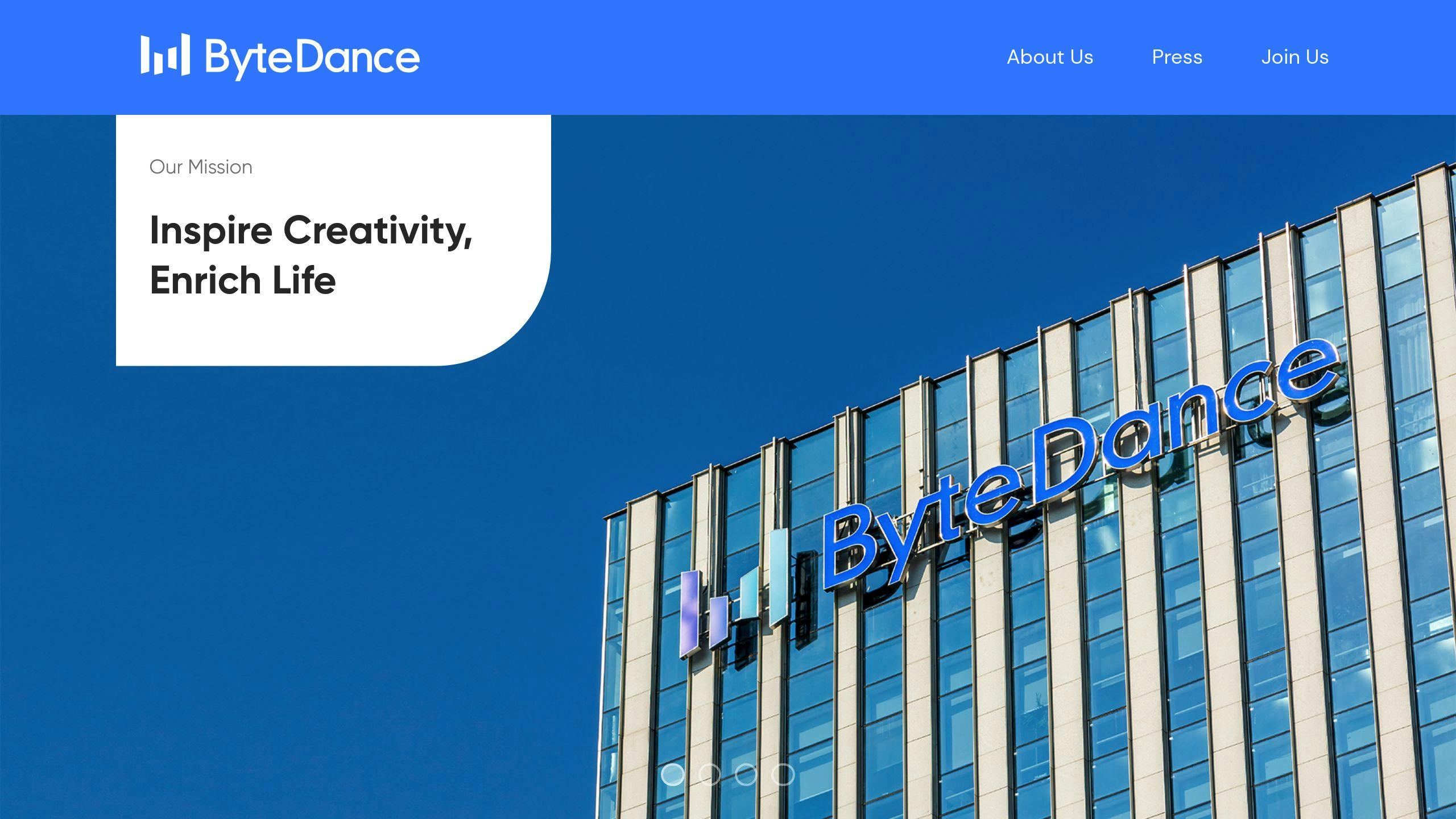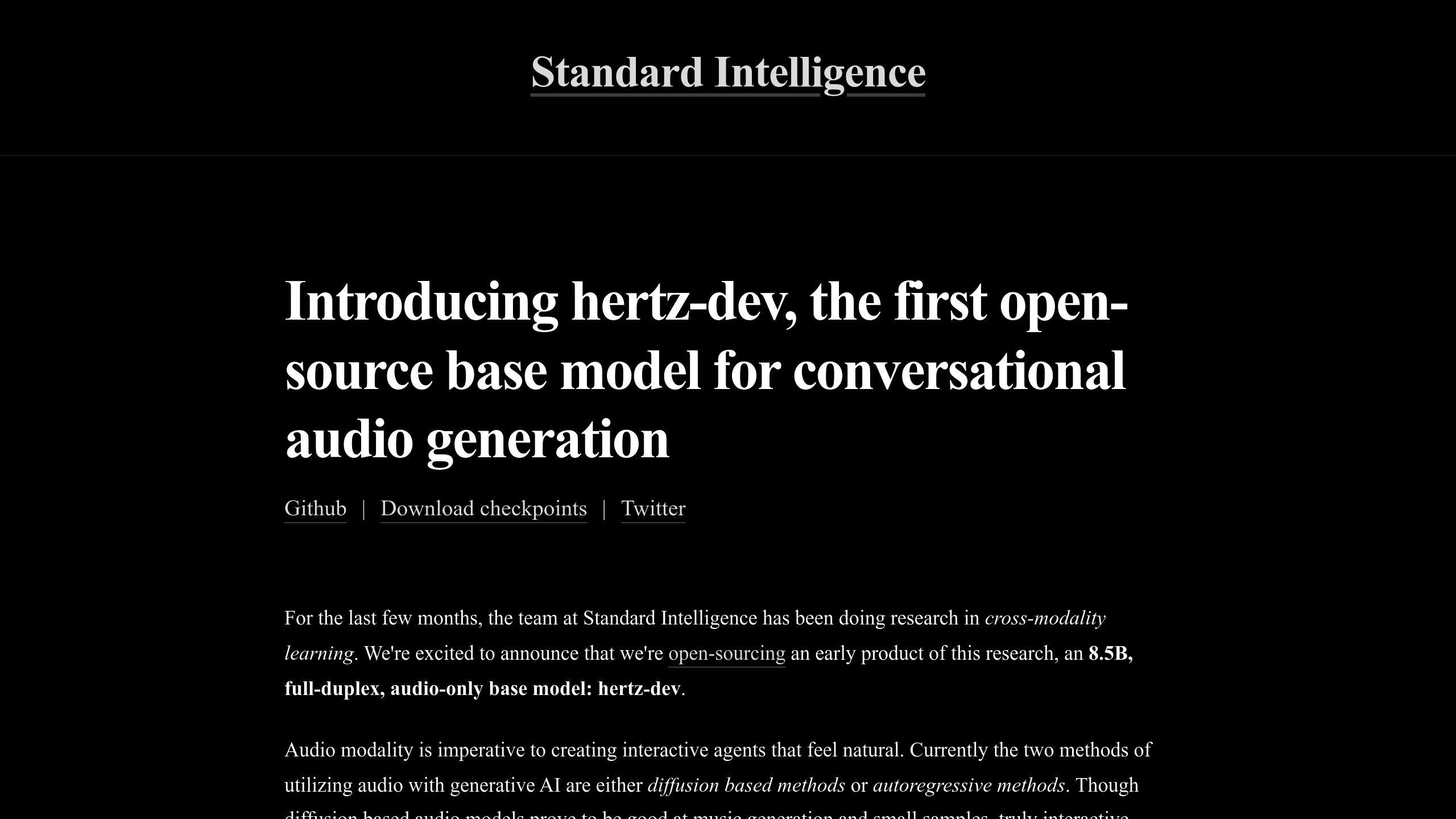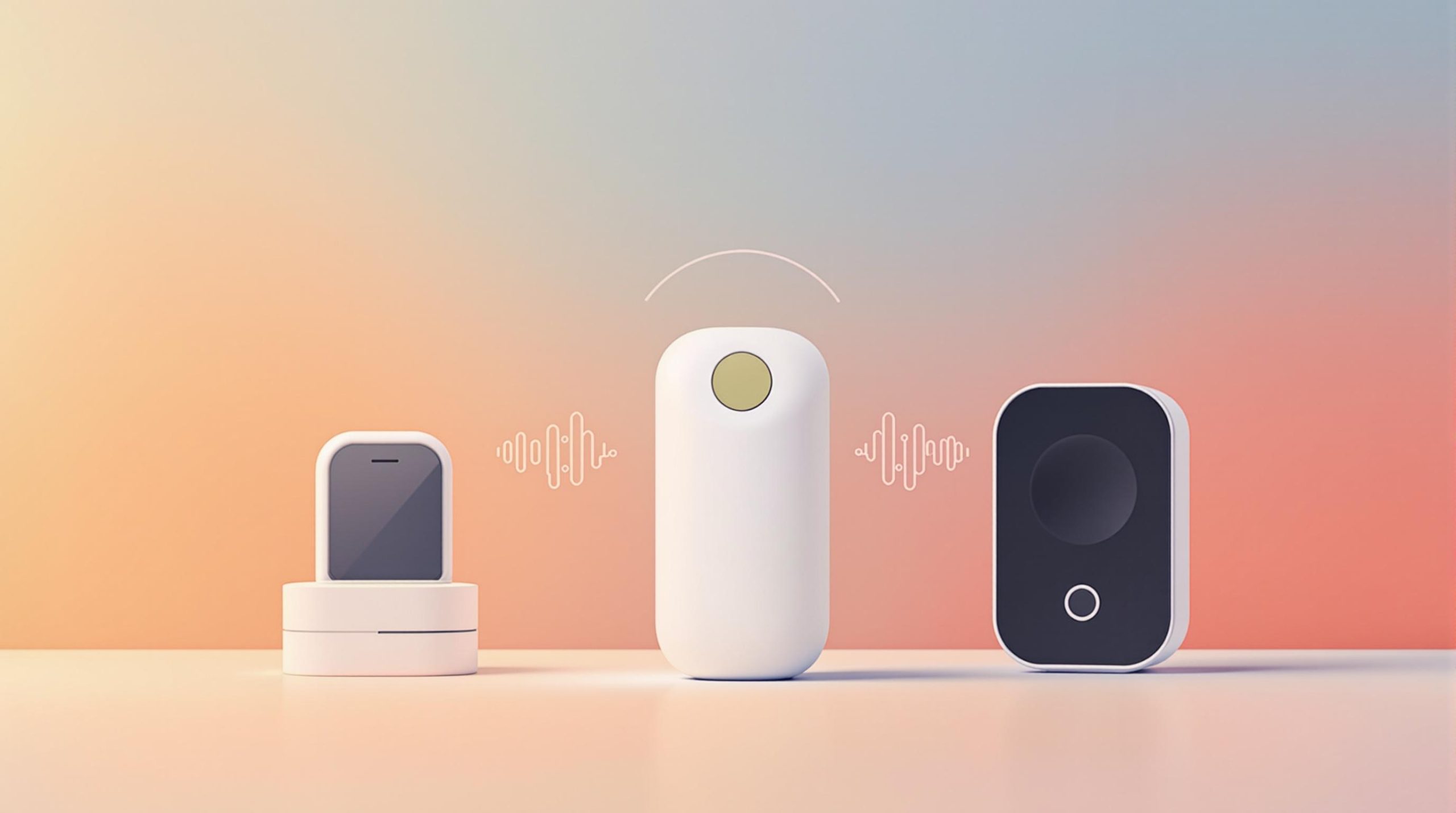AI voice technology is evolving rapidly with full duplex speech models, enabling real-time, natural conversations by listening and speaking simultaneously. Here’s how the key players compare:
- ChatGPT Advanced Voice: Multimodal interactions with emotional nuance but lacks simultaneous listening and speaking.
- Kyutai‘s Moshi: Offline-capable, 200ms latency, and excels in dynamic, real-time conversations.
- ByteDance‘s LSLM: Strong in noisy environments, handles interruptions, and supports multi-user settings.
- SI’s Hertz-dev: Fastest latency (120ms), long memory (17 minutes), and works on consumer hardware.
Quick Comparison
| Model | Strengths | Limitations | Best Use Cases |
|---|---|---|---|
| ChatGPT Advanced | Emotional nuance, multimodal input | No full-duplex capability | Virtual assistants, presentations |
| Kyutai’s Moshi | Offline use, dynamic conversations | Higher latency in practice (200ms) | Smart homes, local applications |
| ByteDance LSLM | Noise resistance, multi-user support | Resource-intensive | Noisy environments, customer service |
| SI’s Hertz-dev | Fastest latency, long context memory | Requires high-end GPU for optimal use | Customer support, analytics |
These models are reshaping industries like customer service, smart homes, and education by improving real-time voice interactions. While each has unique strengths, the competition is driving rapid advancements in conversational AI.
Related video from YouTube
1. ChatGPT Advanced Voice Mode Features
ChatGPT Advanced Voice Mode takes AI voice interactions to the next level by combining audio and visual processing through its GPT-4o architecture. This allows for direct audio processing and generation, making conversations feel more natural and engaging [2].
Real-time Interaction
The voice mode processes user speech in real-time, reducing delays and enabling smooth, uninterrupted conversations. This makes interactions feel fluid and more like speaking with another person [2].
Voice Processing Capabilities
What sets ChatGPT Advanced Voice Mode apart is its ability to understand and respond to subtle details in human speech. Here are two key features:
| Feature | Description |
|---|---|
| Emotional Nuance | Detects and reacts to changes in emotional tone. |
| Adaptive Responses | Adjusts to user pace and provides context-aware replies. |
Practical Applications
ChatGPT Advanced Voice Mode can be applied in various scenarios, such as:
- Interactive presentations with live responses.
- Voice-driven teamwork using visual aids.
- Long, conversational interactions for immersive experiences [2].
That said, the system currently lacks the ability to speak and listen simultaneously, which limits its usefulness in situations like live customer support [2][3]. Competitors such as ByteDance’s LSLM and Kyutai’s Moshi are already exploring simultaneous audio processing, which could give them an edge in this area [1][3]. While ChatGPT excels in many aspects, this limitation highlights room for improvement.
2. Kyutai‘s Moshi Capabilities

Kyutai’s Moshi takes full-duplex speech technology to the next level, using the 7B parameter Helium multimodal model to process both text and audio seamlessly [6]. Unlike ChatGPT, Moshi can listen and speak at the same time, making it perfect for dynamic, real-time conversations.
Real-time Interaction
Moshi uses an "Inner Monologue" method to predict text before generating audio. This ensures responses are smooth and linguistically precise, creating conversations that feel more natural and human-like [5].
Simultaneous Listening and Speaking
Here’s how Moshi handles full-duplex communication:
| Capability | Description |
|---|---|
| Dynamic Conversation Flow | Manages interruptions while maintaining context and generating accurate responses |
| Streaming Recognition | Processes speech and creates responses at the same time |
| Context-Aware Responses | Adapts tone and phrasing to fit the flow of the conversation |
Performance Highlights
Moshi performs reliably even in noisy environments, thanks to its advanced architecture [6]. One standout feature is its ability to run offline via local installation, ensuring it works without an internet connection.
Real-World Uses
Moshi’s features make it especially useful for:
- Offline Environments: Ideal for smart homes or secure locations where local processing is essential.
- Industrial Applications: Supports voice-controlled machinery in areas with limited connectivity.
- Customer Interaction: Perfect for services requiring lifelike, nuanced conversations.
While Moshi shines in real-time and offline scenarios, ByteDance’s LSLM offers its own approach to full-duplex communication, which will be discussed in the next section.
3. ByteDance‘s LSLM Strengths

ByteDance’s LSLM pushes the boundaries of full-duplex speech technology with its end-to-end design, capable of processing audio and generating responses at the same time.
Real-time Processing and Communication
LSLM employs a streaming encoder system to process audio as it happens, paired with a decoder-only TTS system for generating speech [3]. This setup allows for true two-way communication, where the model listens, responds, handles interruptions, and keeps track of the conversation’s flow – all in real-time.
| Feature | Capability |
|---|---|
| Full-Duplex Modeling | Listens and speaks simultaneously |
| Streaming Processing | Analyzes audio as it’s received |
| Response Generation | Produces speech instantly during talks |
| Interruption Handling | Smoothly manages conversational shifts |
Handling Complex Environments
LSLM performs reliably in tough settings, easily managing background noise, multiple speakers, and unfamiliar voices [3]. This makes it a great fit for scenarios where sound conditions are unpredictable and constantly changing.
Real-World Uses
The flexibility of LSLM makes it suitable for various applications, such as:
- Real-time voice chat moderation with content filtering
- Multi-user settings that need speaker recognition
- Noisy workplaces or industrial environments
- Interactive customer service that feels natural
Its ability to handle unfamiliar voices and deliver consistent performance in different acoustic conditions makes LSLM a strong choice for industries relying on smooth, real-time voice interactions [3].
While LSLM shines in real-time communication and noise management, SI’s Hertz-dev takes a different route, focusing on advanced speech processing for more specialized needs.
sbb-itb-5392f3d
4. SI’s Hertz-dev Features

SI’s Hertz-dev is a major step forward in full-duplex speech technology. It’s an 8.5 billion parameter model built specifically for real-time conversational AI, packed with features that make it a strong contender in the voice AI space.
Real-time Processing and Speed
Hertz-dev delivers an impressively low latency of just 120ms on a single RTX 4090 GPU – making it 40% faster than ByteDance’s LSLM. This speed ensures smooth, natural conversations that feel more human-like. It processes audio efficiently at 1kbps and benefits from training on a massive 16 million hours of audio, giving it the ability to handle a wide range of acoustic conditions.
| Performance Metric | Value |
|---|---|
| Latency | 120ms |
| Model Size | 8.5 billion parameters |
| Context Memory | 17 minutes |
Handling Long Conversations
Thanks to its full-duplex transformer architecture, Hertz-dev can maintain conversation coherence for up to 17 minutes. This makes it ideal for longer interactions. Its robust base model performs consistently across different voice types and environments.
"Base models are uniquely valuable as a research product because they accurately model the distribution of the data that they were trained on." – Anonymous Contributor, Hacker News
Real-world Uses
Hertz-dev’s mix of low latency and long context memory makes it a great fit for:
- Real-time customer support that needs fast, context-aware replies
- Voice-driven data processing for interactive analytics
- Long conversations where maintaining context is critical
Its Apache-2.0 license makes it accessible for both commercial and independent use. Plus, the ability to run on consumer-grade hardware lowers the barrier for developers and startups. With its open-source approach, Hertz-dev encourages innovation and collaboration across the development community.
Strengths and Weaknesses of Each Model
Full-duplex models come with their own set of advantages and challenges. Here’s a breakdown of how they perform in key areas:
| Model | Strengths | Limitations | Best Use Cases |
|---|---|---|---|
| ChatGPT Advanced Voice | • Handles multimodal inputs seamlessly • Smooth real-time conversations • Detects emotional tone effectively |
• Struggles with noise interference • Limited handling of unknown speakers |
Enterprise communications, Virtual assistants |
| Kyutai’s Moshi | • Promises 160ms latency • Works offline • 7B parameter multimodal design |
• Actual latency higher at 200ms • Noise resistance details unclear |
Smart home devices, Local applications |
| ByteDance LSLM | • Strong at filtering out noise • End-to-end architecture • Real-time SSL encoding |
• Higher latency • Demands significant resources |
Noisy environments, Multi-user scenarios |
| SI’s Hertz-dev | • Low latency of 120ms • Context memory for up to 17 minutes • Works with consumer hardware |
• Optimal performance requires RTX 4090 GPU • Heavy 8.5B parameter load |
Real-time customer support, Interactive analytics |
Each model offers distinct features tailored to different needs. For instance, ChatGPT Advanced Voice is ideal for nuanced conversations [2], while Kyutai’s Moshi is better suited for offline or local applications [6]. ByteDance LSLM thrives in noisy, multi-user environments [3], and SI’s Hertz-dev provides a balance between speed and compatibility.
"Full-duplex systems are driving adoption due to superior real-time capabilities." [4]
This comparison highlights how these models cater to specific use cases, whether it’s enterprise-level communication, smart home functionality, or handling challenging audio conditions. Each one brings something unique to the table, reflecting the evolving landscape of full-duplex AI technologies.
Final Thoughts
Full duplex speech models are changing the way we experience AI voice interactions by enabling real-time, natural communication. Platforms like ChatGPT Advanced Voice, Kyutai’s Moshi, ByteDance LSLM, and SI’s Hertz-dev each bring their own strengths to the table. For instance, ByteDance’s LSLM shows how these models can replicate human-like dialogue, setting a high bar for conversational AI [3].
These advancements are already making an impact in industries such as healthcare, education, and customer service. Real-time voice processing is opening doors to new possibilities, like interactive customer support, innovative educational tools, and improved healthcare services.
"Full-duplex conversational systems will continue to see adoption growth due to their ability to provide real-time understanding and simultaneous information flow" [4]
That said, challenges remain. Platforms like Moshi AI, with its 7B parameter multimodal design, excel in offline functionality, while LSLM stands out for its noise resistance. However, each system still grapples with balancing performance and resource demands [2][3]. As these technologies evolve, the spotlight is on improving both efficiency and accessibility.
The future looks promising, with efforts focused on reducing latency, improving resource efficiency, enhancing contextual understanding, and boosting noise resistance. The competition between platforms is fueling constant progress, making AI voice interactions more seamless and accessible for everyday use.
Each model has its own standout feature – Hertz-dev’s low latency, Moshi’s offline functionality, LSLM’s noise resistance, and ChatGPT’s emotional intelligence. Together, they highlight how full duplex technology is advancing to meet a variety of practical needs. As these systems continue to improve, AI voice interactions are set to become a natural part of daily communication, driven by increasingly capable and efficient technology.
FAQs
Does ChatGPT have a voice feature?
Yes, ChatGPT includes a voice feature that allows for natural, near real-time conversations. While it handles voice interaction well, it doesn’t yet support full-duplex communication (where it can listen and speak simultaneously) like some competitors. Its voice feature is notable for:
- Emotional awareness and responsive interactions
- Smooth management of conversation flow
- Character-specific voice customization
- Availability across different user tiers
Can ChatGPT create voices?
Yes, ChatGPT can generate realistic voices with emotional depth and character-specific tones using its voice synthesis technology. This makes it useful for a variety of applications:
| Application | Benefit |
|---|---|
| Customer Service | Always available, human-like interactions |
| Virtual Assistants | Real-time responses with emotional cues |
| Voice Chat Moderation | Active monitoring and appropriate responses |
| Educational Tools | Engaging, conversational learning tools |
For best results, ChatGPT works well in quiet settings with clear audio input. While it performs impressively in voice generation and emotional expression, competitors like ByteDance’s LSLM handle noisy environments more effectively [3].
Although ChatGPT’s voice capabilities represent a leap forward in conversational AI, full-duplex models like Kyutai’s Moshi and SI’s Hertz-dev set themselves apart by enabling simultaneous listening and speaking, which is especially useful in real-time applications [1] [3].

